Guide to UK Deer ID
12-09-2025
Discriminating between the different species of deer that occur in the UK is evidently one of the most challenging aspects of spotting on MammalWeb. Contributor Marc Baldwin has kindly put together this guide to help with that task. We have found it very useful and we hope you do too!
Identifying Deer
There are seven species of deer that you could bump into while out and about in the wilds of Britain. Red deer (Cervus elaphus) and roe deer (Capreolus capreolus) are both considered native to the UK and are quite widely distributed, albeit reds have a much patchier distribution than roe. Reindeer (Rangifer tarandus) are also technically native, but confined to a herd owned by The Reindeer Company that has free range over part of the Cairngorms in Scotland. So, unless you have your trailcam in this fenced area, or your garden trailcams are out on Christmas Eve/morning, you're vanishingly unlikely to capture a reindeer. The remaining four - European fallow (Dama dama), Japanese sika (Cervus nippon), Reeves' muntjac (Muntiacus reevesi), and water deer (Hydropotes inermis) - are introduced species, the first originating in the Mediterranean and the remaining three from Asia. The distribution of water deer and sika remains relatively limited, while muntjac and fallow are now ubiquitous across Britain.
Despite there being only a handful of species, deer can be tricky to identify, particularly from a black and white trailcam photo or the glimpse of one legging it into the undergrowth. It's important, however, that we strive to ensure accurate identification, because citizen science projects such as MammalWeb are important tools in monitoring distribution changes in these species, particularly the invasive ones. In this article, we're going to take a brief canter through some of the key features that can help pin down the species staring back at you from in front of the lens.
Red
This is by far our largest deer species, and size alone can often be the key determinant. When viewed in full colour a short brick-red (summer) or longer grey-brown (autumn/winter) coat sporting a yellow-cream rump patch (also known as the "target") with a moderate tail and no dark markings is indicative of red deer. During the winter, the males (stags) grow a mane. To my eye, this species, and adult females in particular, have a comparatively long face, giving something of a regal or looking-down-its-nose-at-you appearance. A paler streak around the eyes and/or nose is often evident.
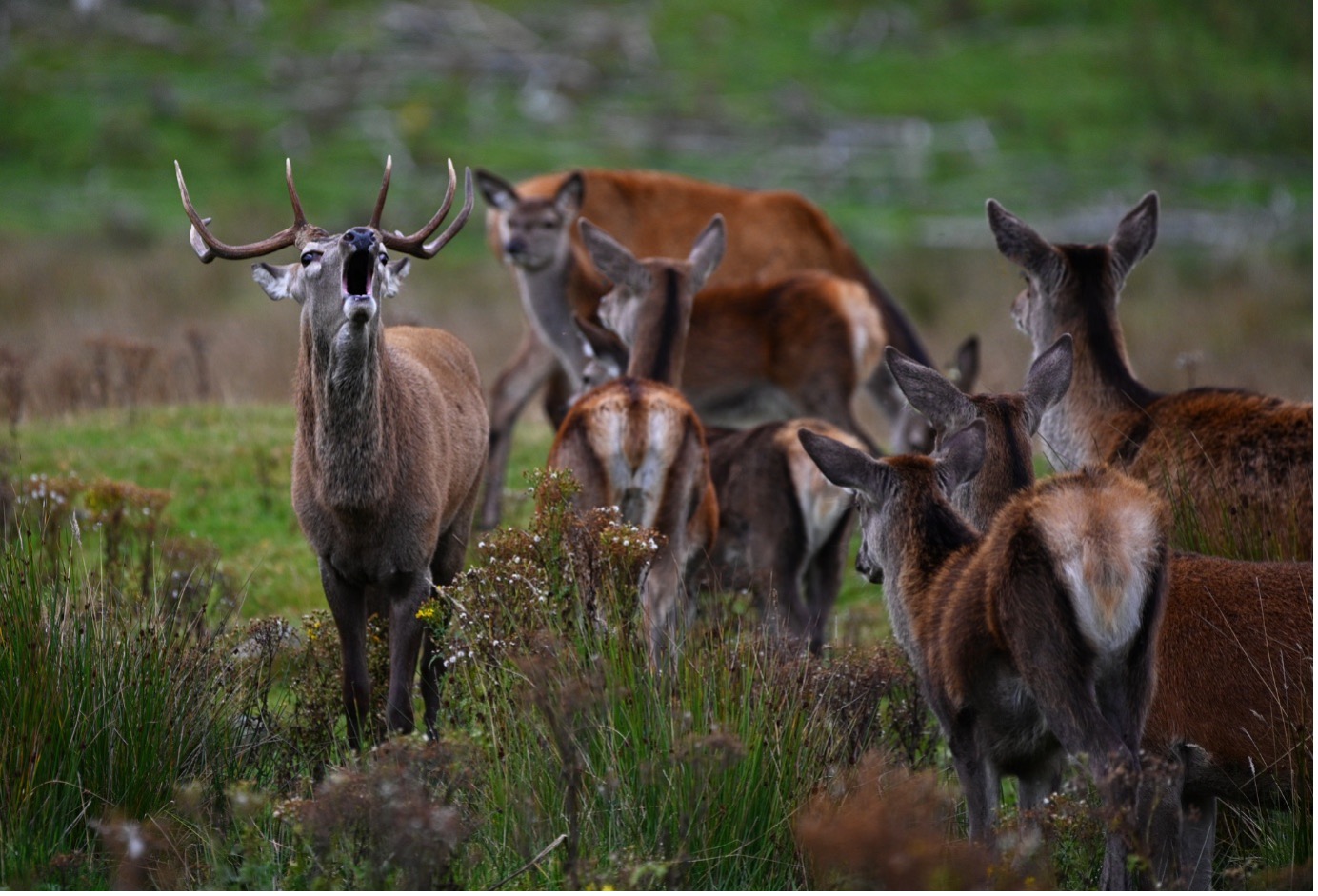
Red deer (Image: Marc Baldwin)
Roe
Adults of this species have a uniform/unspotted coat, with both males (bucks) and females (does) sporting a white rump with no obvious tail nor dark markings. Unlike any of our other antler-growing species, males re-grow their antlers over winter, so if you see a deer in velvet during December, January or February, it'll almost certainly be a roebuck. (I say almost certainly, because there are conditions or injuries that can cause deer to retain their velvet and antlers abnormally, but these are uncommon.) Once the velvet is shed, the bucks have simple spiked antlers, typically with three points. Females have a distinct white tuft in the middle of the rump called a tush. Perhaps the most obvious character of this species, if you get a photo of the face, is that both sexes (and even young fawns) possess a dark stripe either side of the nose, giving a moustached appearance.
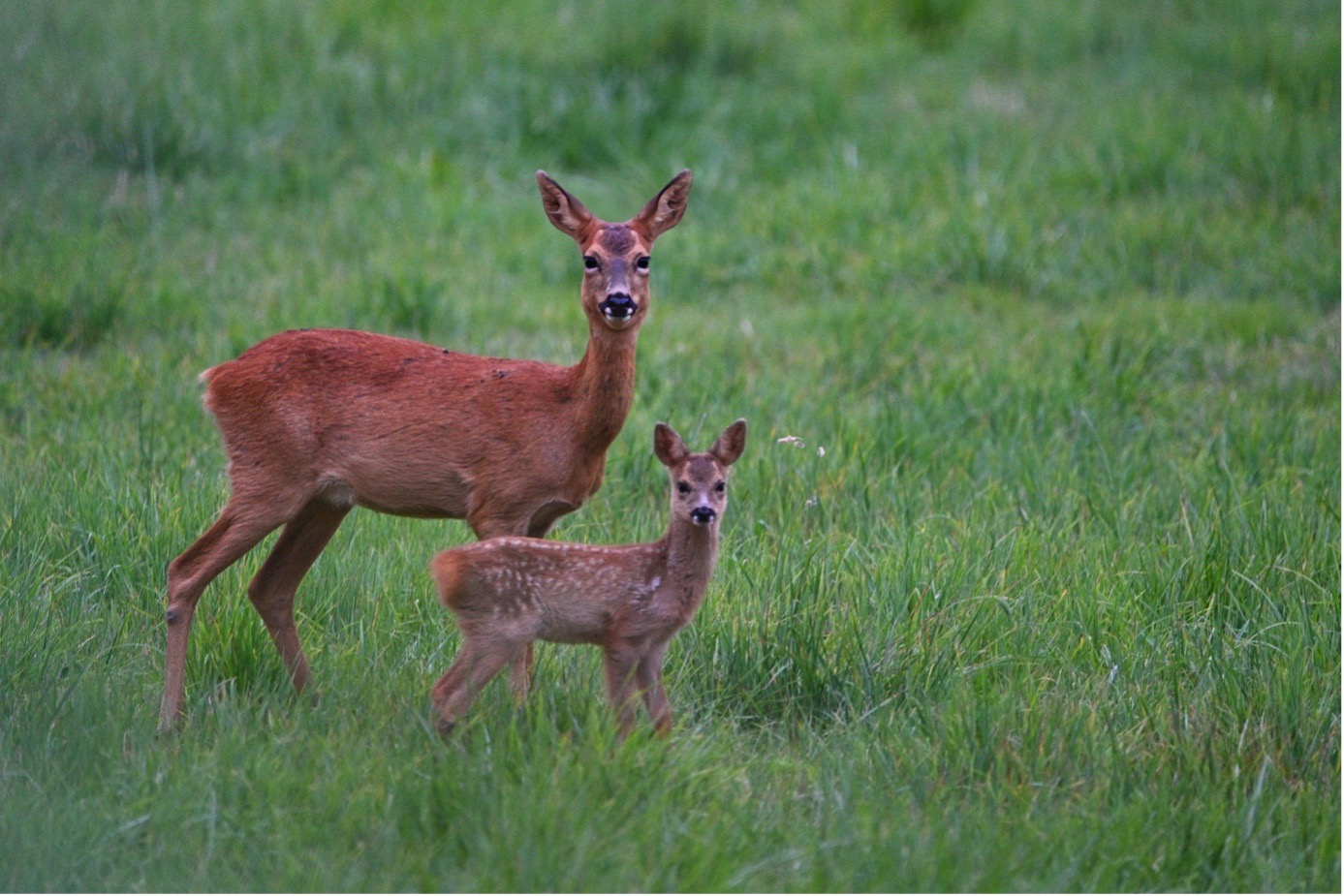
Roe deer (Image: Marc Baldwin)
Japanese Sika
One key identification feature of Sika is a white rump patch with dark horseshoe-shaped fringe, but without the long tail or tail stripe of a Fallow. The second is a pale U-shaped marking across the brow, giving both sexes of all ages the appearance of frowning. Additionally, a dark stripe runs the length of the back, from the base of the skull, with pale/white spots flecking a chestnut-brown-to-blackish coat. Males have a short mane during the autumn rut, and their antlers are much more simply spiked, with fewer branches than red deer.
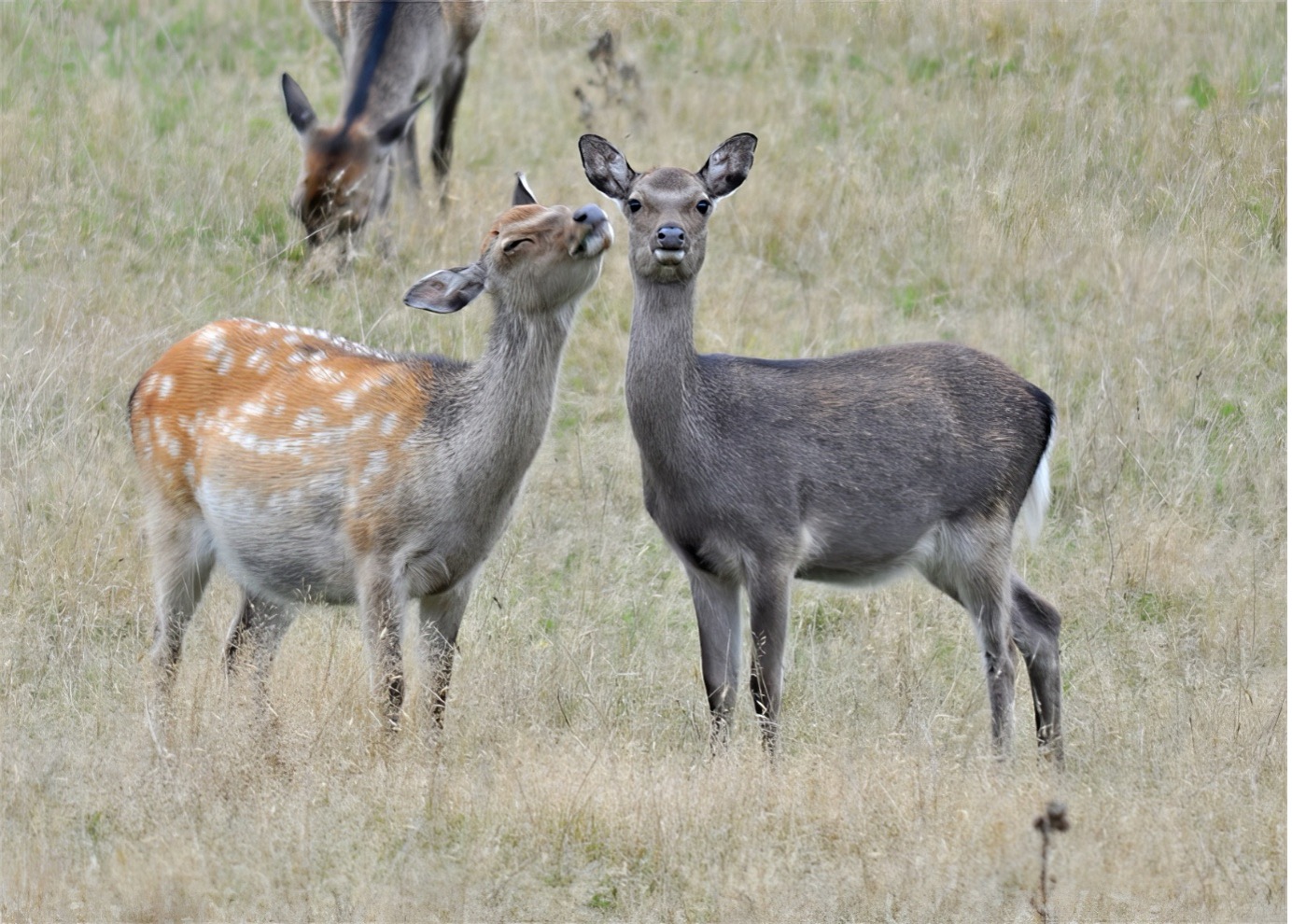
Sika deer (Image: Marc Baldwin)
Chinese water deer
This small species exhibits a uniform short brick-red coat in summer, moulting to a longer and paler one in winter. Large, rounded ears and large black eyes give them a "teddy bear" appearance. The hind quarters are significantly more muscular than the chest and forelegs. Indeed, the hind quarters are higher than the shoulders, but less so than the muntjac, making the back appear straighter. A pale ring is usually present around the eyes and nose. Mature males have long tusks that protrude below the upper lip, although these often get broken, and females occasionally present with tusks, so it's not always a reliable sexing tool. In my experience, water deer are frequently confused with both roe and muntjac.
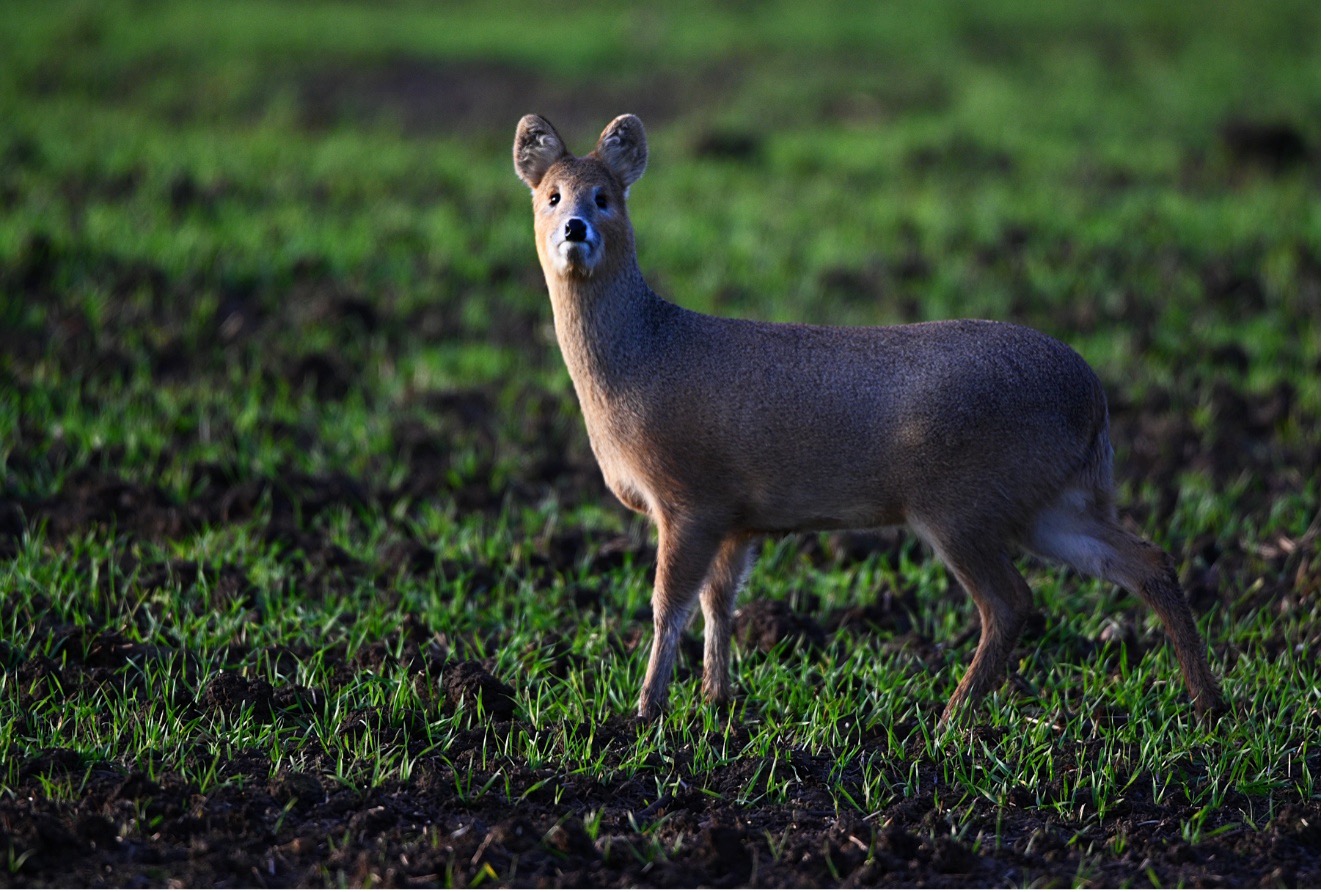
Chinese water deer (Image: Marc Baldwin)
Reeves' muntjac
Our smallest deer species. Males and females have a dark brown coat without any striking marking. A long, wide tail that's brown on the top and white underneath is flagged when alarmed. The ears are smaller, more oval-shaped, and less well furred than water deer and the back more arched, sometimes giving a pronounced hunched posture. Both sexes present with dark line markings on the face - males exhibit a V- and females a W-shaped mark. Both species possess short tusks, and males have short antlers with exceptionally long pedicles (the bony stumps on the top of the skull from which the antlers grow).
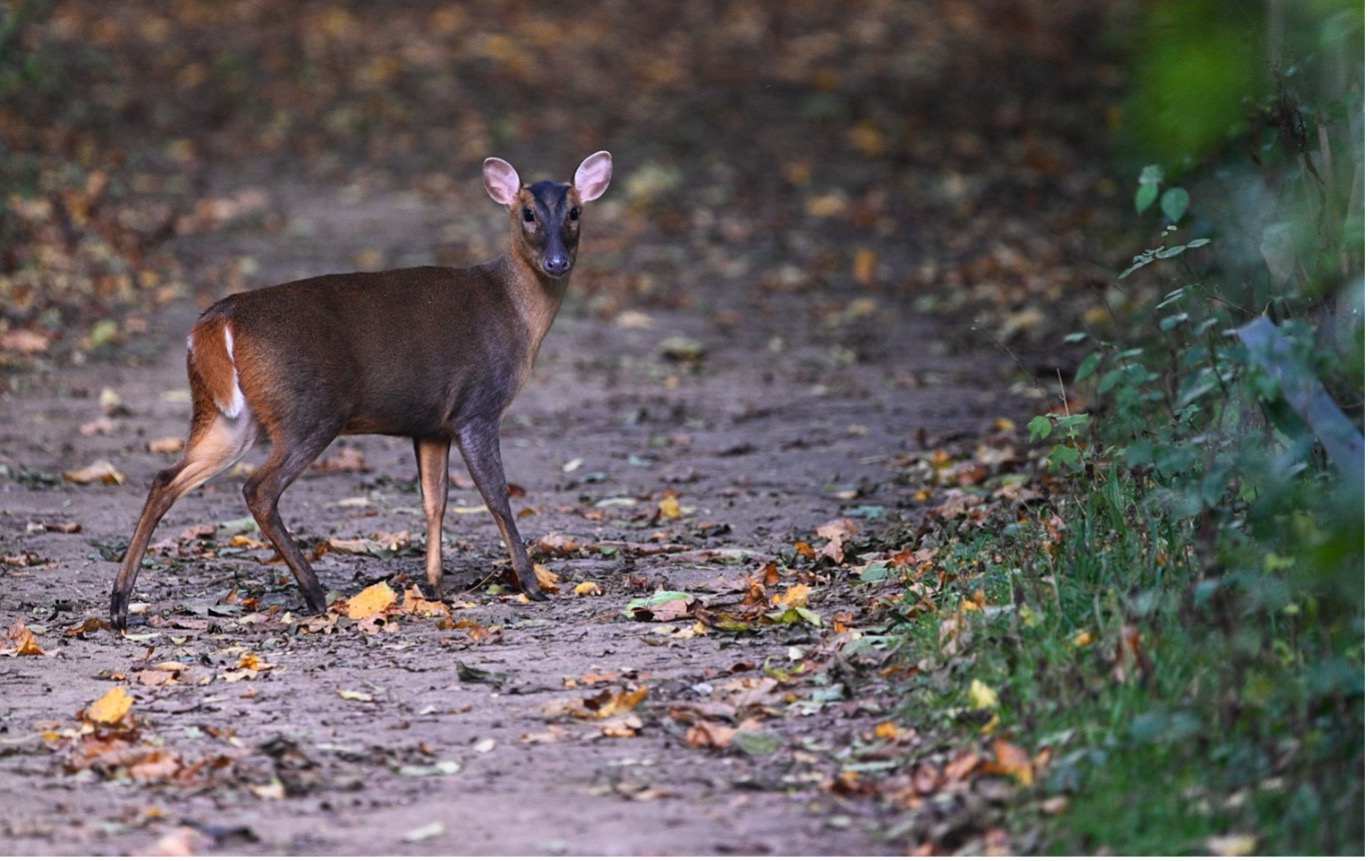
Reeves' muntjac (Image: Marc Baldwin)
Fallow
Short, bright chestnut/red-brown coat with white spots in summer; grey-brown in winter with less distinct spots. The flanks are often heavily white spotted on a light/chestnut brown backing, but there's huge variation in colour. A dark line runs the length of the back in the summer coat. The rump is white with a black border that forms an inverse horseshoe shape, and the relatively broad, long (by deer standards) tail has a black stripe down middle. Males possess large palmated (flattened) antlers, increasing in size and palmation with age. Males don't grow a mane during the autumn rut as red and sika stags do but display a very prominent Adam's apple. This is the species that are known to form "super herds" of more than 50 individuals.
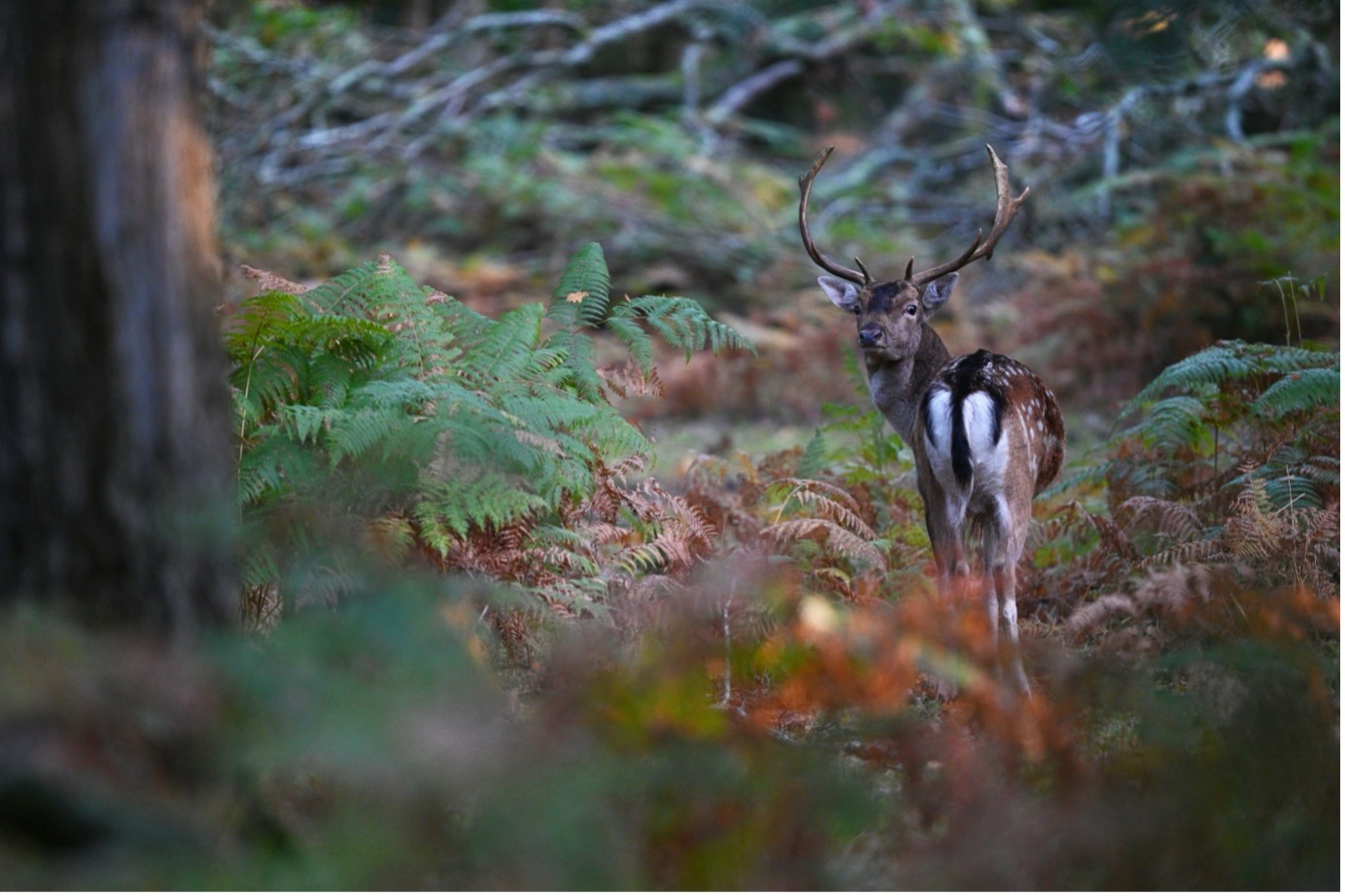
Fallow deer (Image: Marc Baldwin)
For example…
Obviously, it's one thing to get a good look at an animal in decent light while it stands to try and work out what the heck you are (or doesn't notice your camo), but quite a different game when you're working with a couple of frames hastily caught by a trail camera, often in black and white. With this in mind, let's take a look at a few examples from MammalWeb.
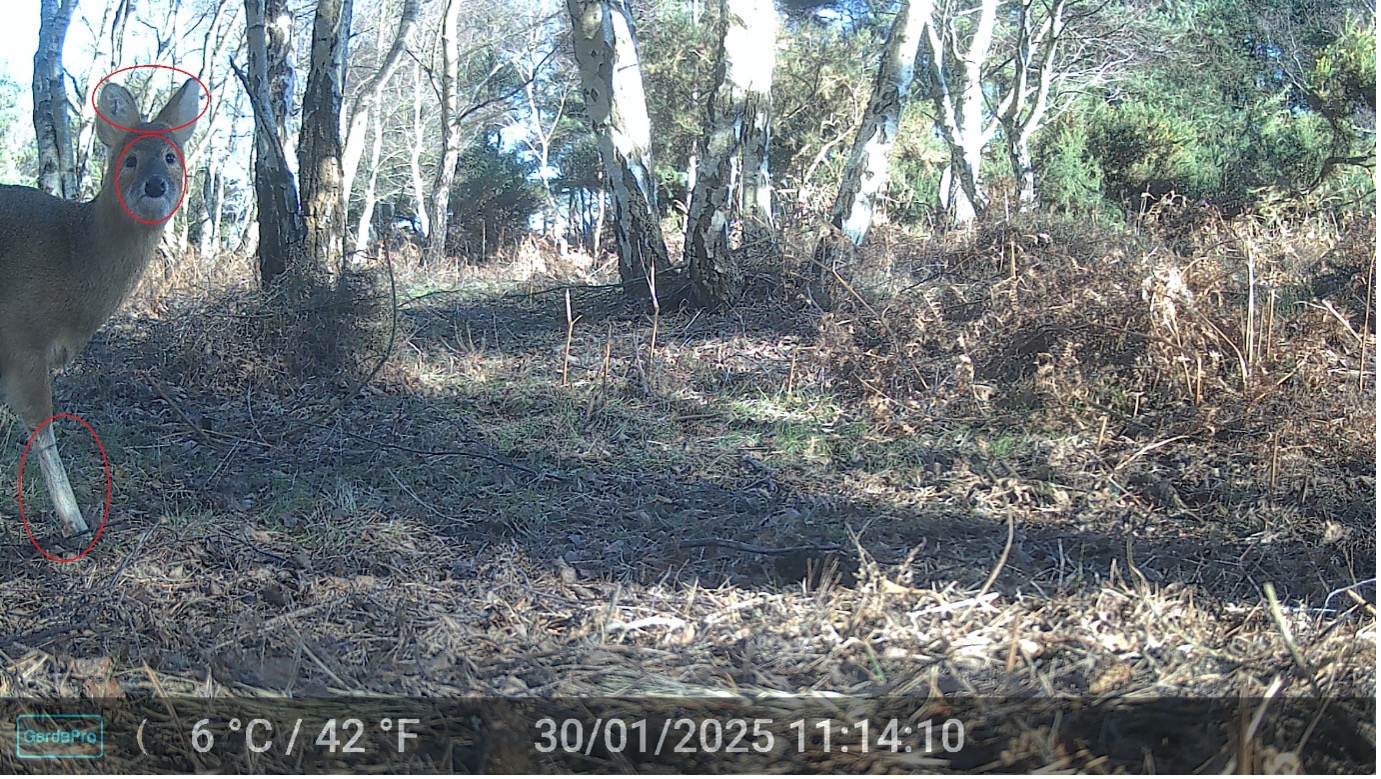
This is a Chinese water deer, probably a buck (male) based on the facial structure. Note the large, rounded, furry ears and the large rounded black eyes and nose, giving a "teddy bear" appearance. White "socks" on the front legs are also common in some populations. (Image: Robin Langdon)
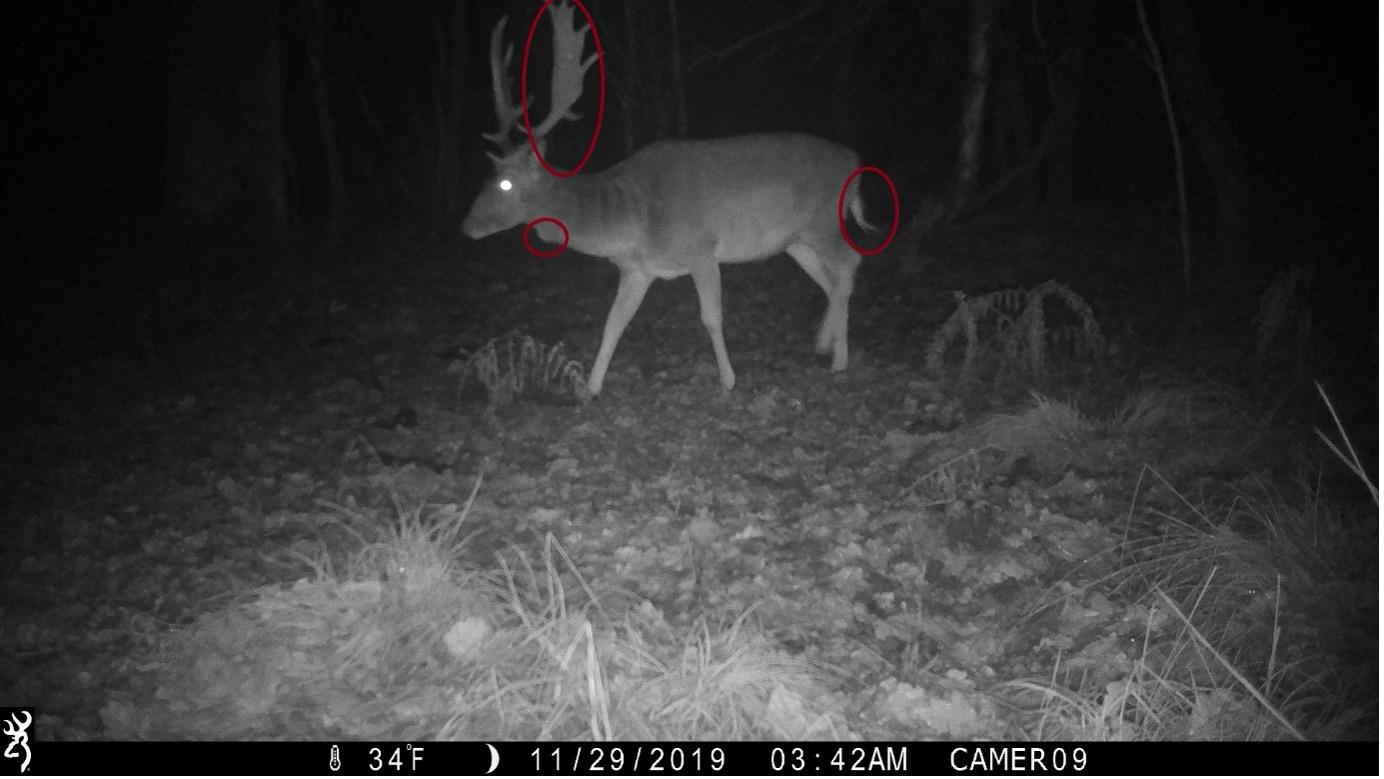
A fallow buck (male) late in the rut. Note the broad splaying (palmation) of the antlers, Adam's apple, and the long tail. (Image: Sian Green)
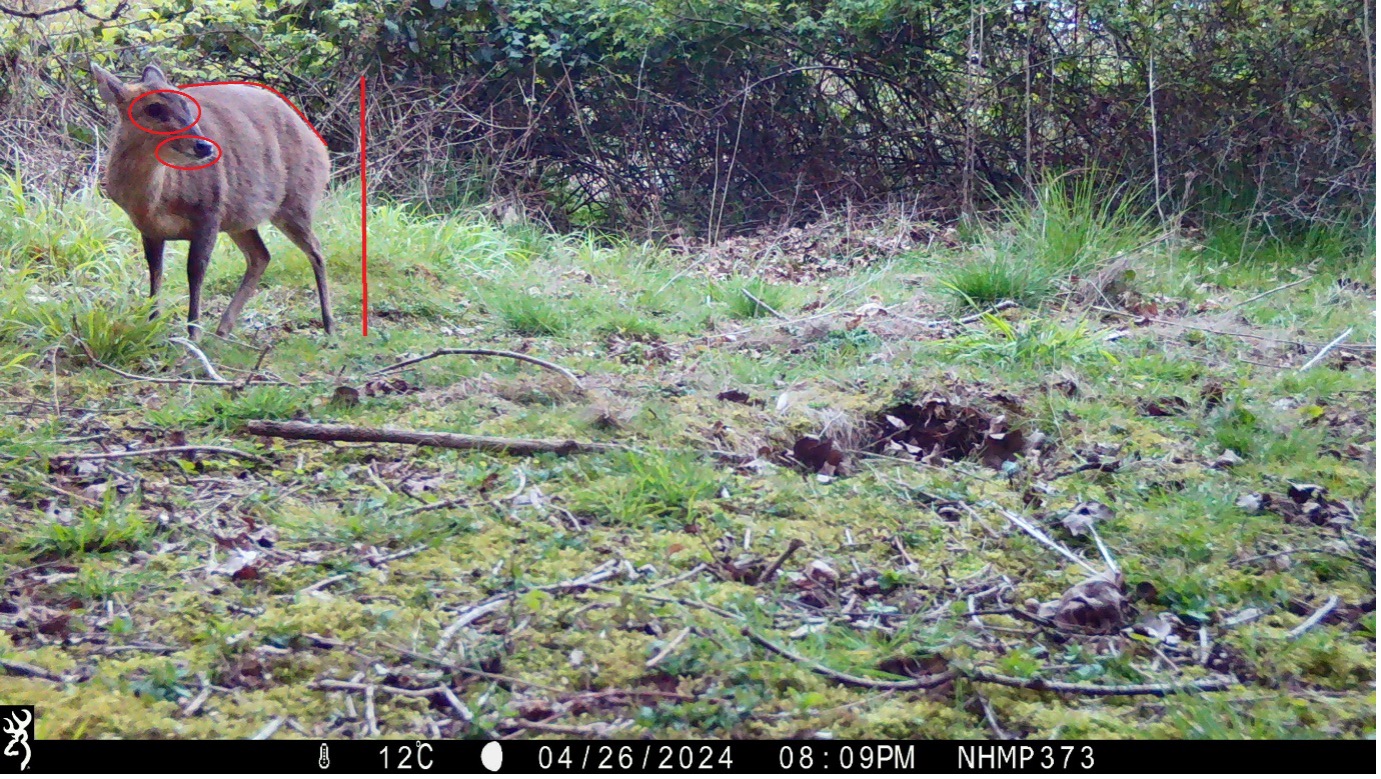
A muntjac doe (female). A short-statured deer, with a rounded back (giving a "hunched" appearance). Darker markings on the forehead, and the "smile" is also a common feature in females. (Image: Deborah Wright / NHMP Warwickshire)
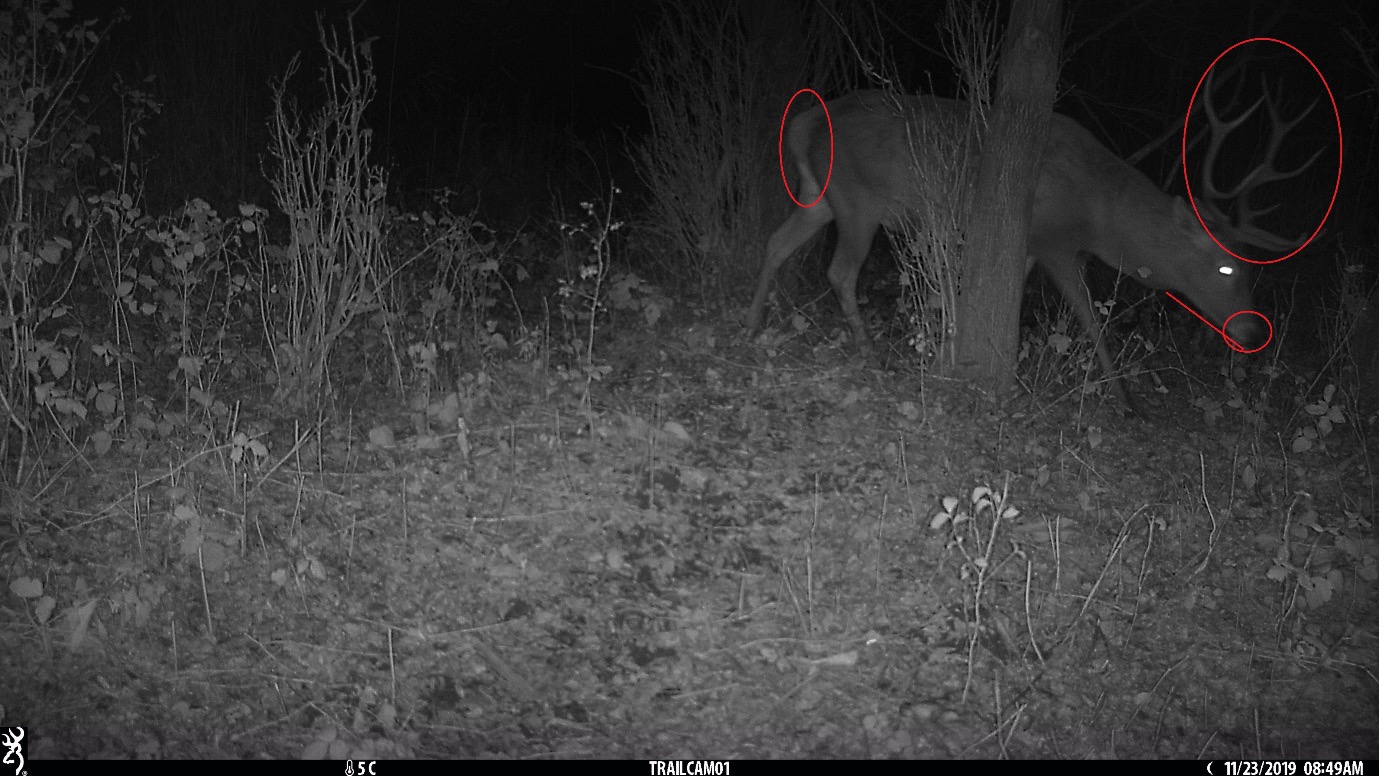
Red deer stag (male). A large deer, as evidenced by the surrounding vegetation, with a lighter rump patch with barely discernible tail, plus the long face, pale band around the nose, and branched antlers. (Image: Kovács Attila)
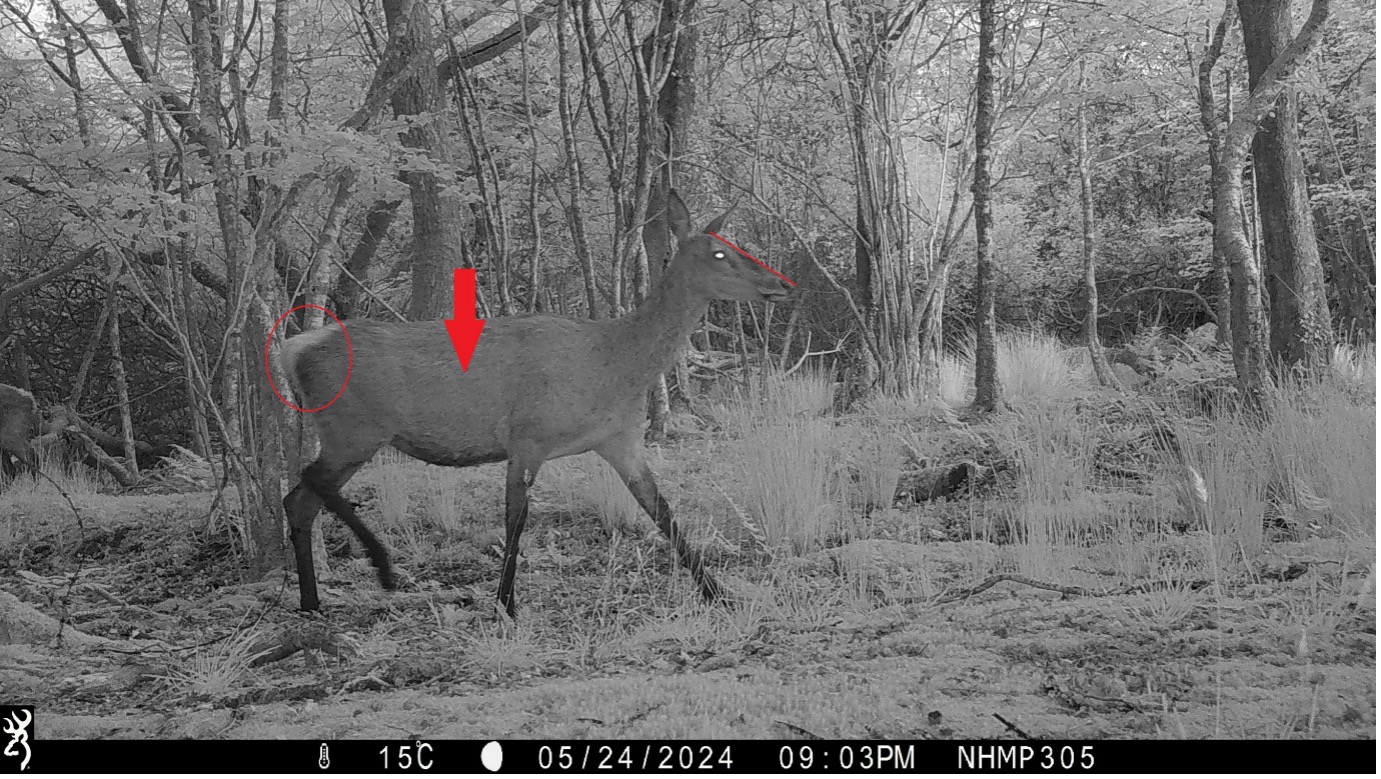
A red deer hind (female). Note the large size relative to the vegetation, off-white rump patch, uniform coat, and proportionally long face. (Image: Abby Whitmore / NHMP Cornwall)
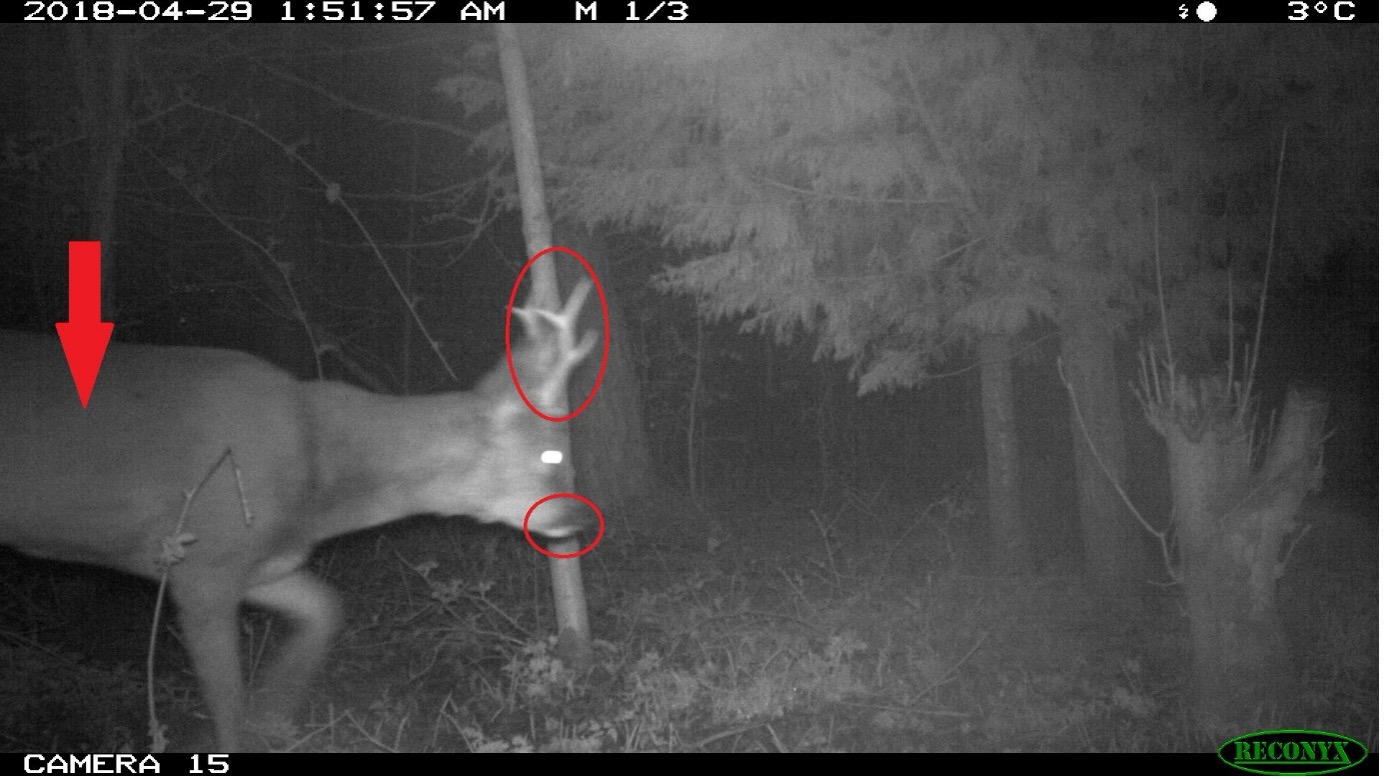
Roe deer buck. Note the uniform coat, simply spiked antlers with three points, and the dark "moustache". (Image: Stuart Millen)
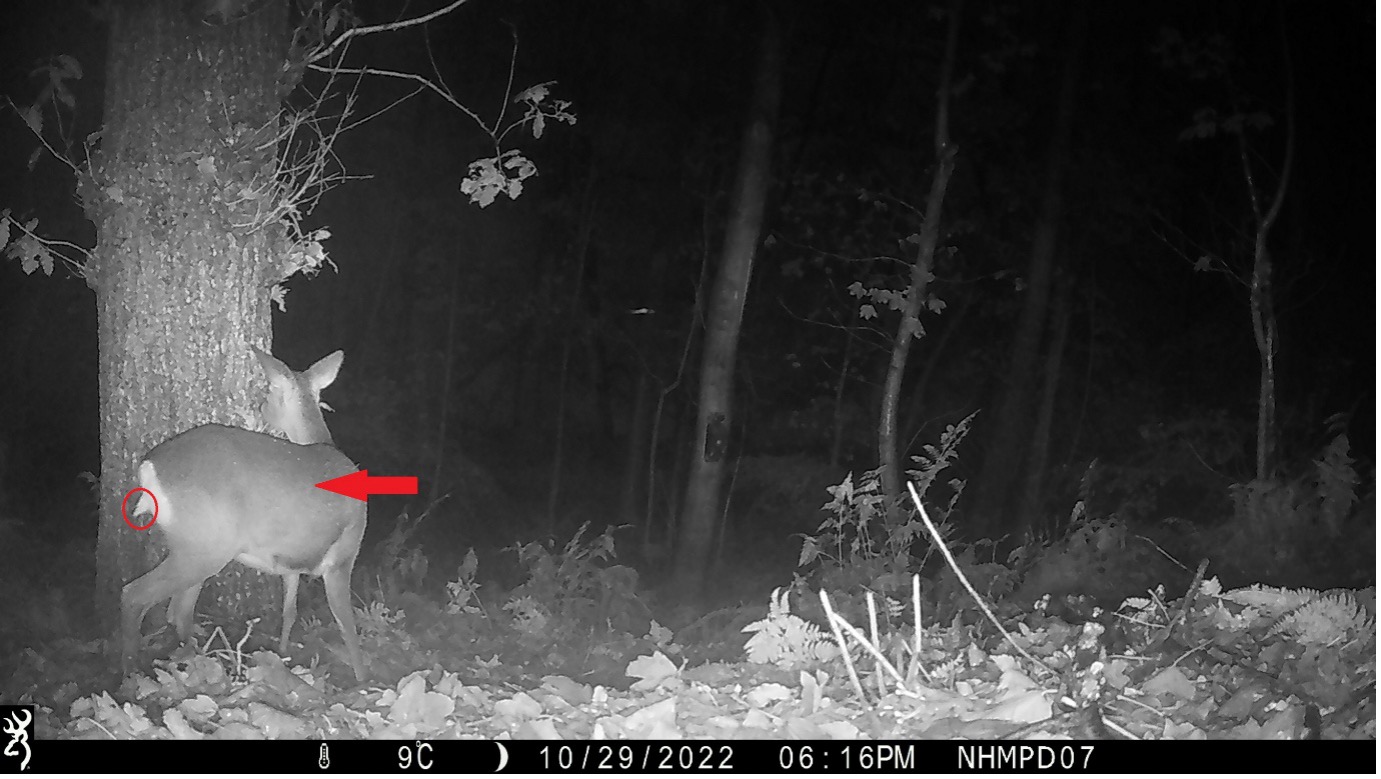
Roe deer doe (female). Note the uniform coat and the white rump patch with the "tush". (Image: Russell Hill / NHMP Durham)
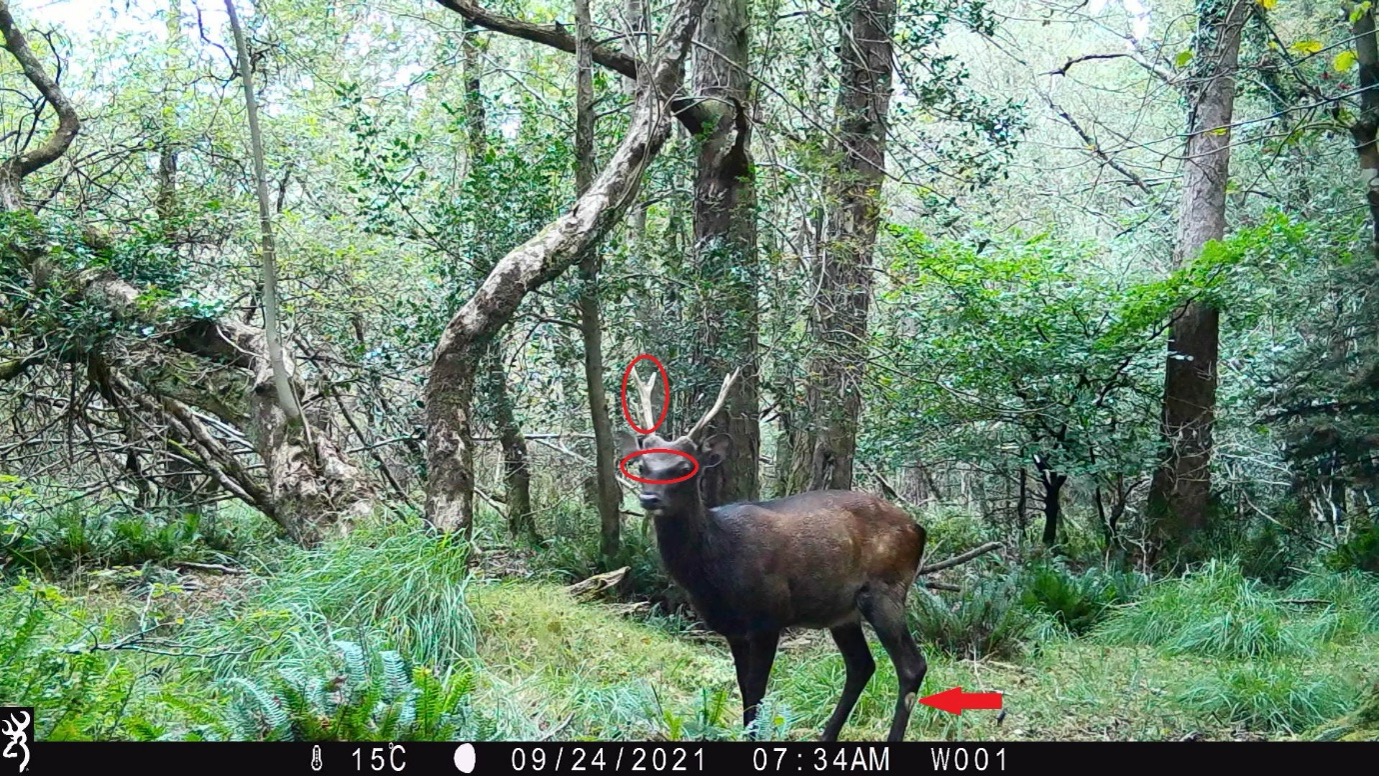
Sika stag. Note the pale hock gland on the hind leg, the raised brow giving a "grumpy" or "frowning" appearance, and the simple non-palmated antlers. (Image: Simone Ciuti)
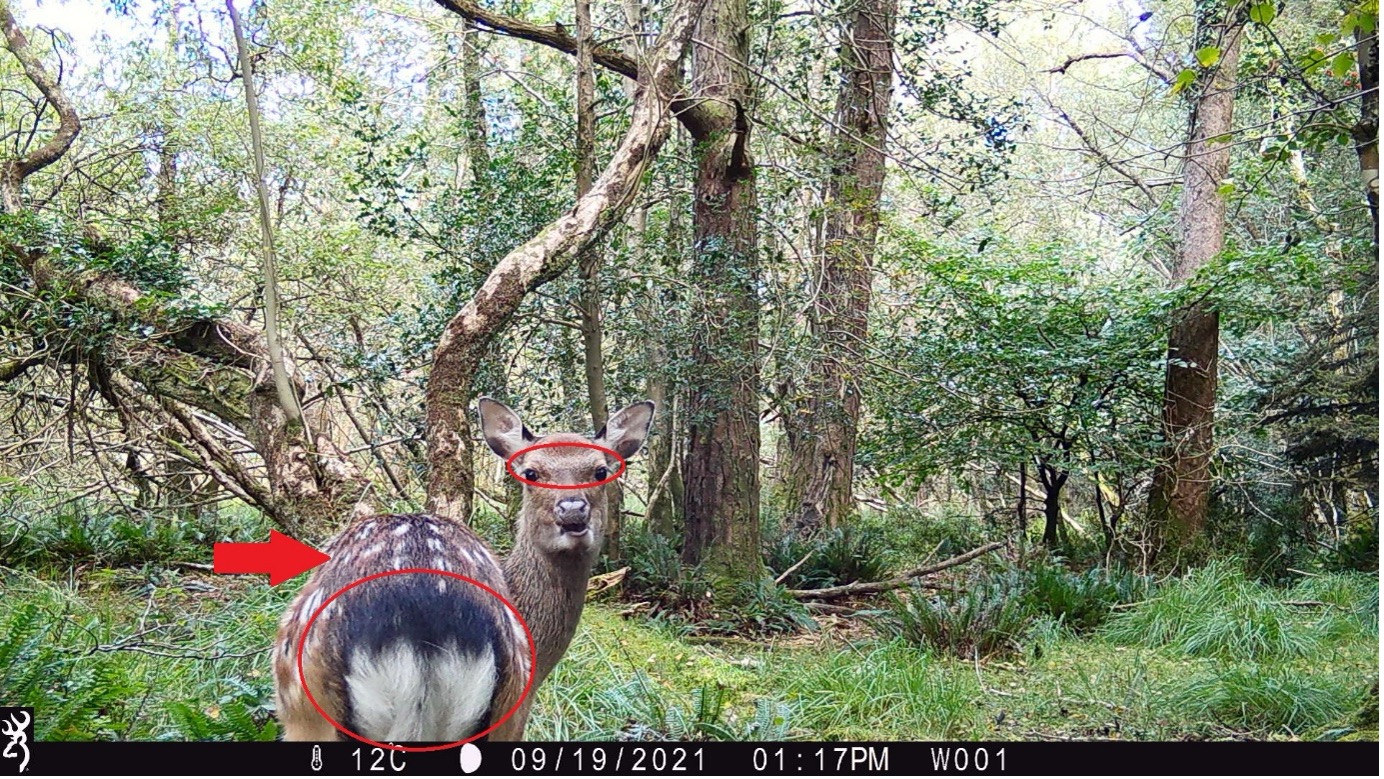
A sika hind (female). Note the raised brow, heavily spotted coat, white rump patch surrounded by a black border and the tail (just to the left) without any markings. (Image: Simone Ciuti)
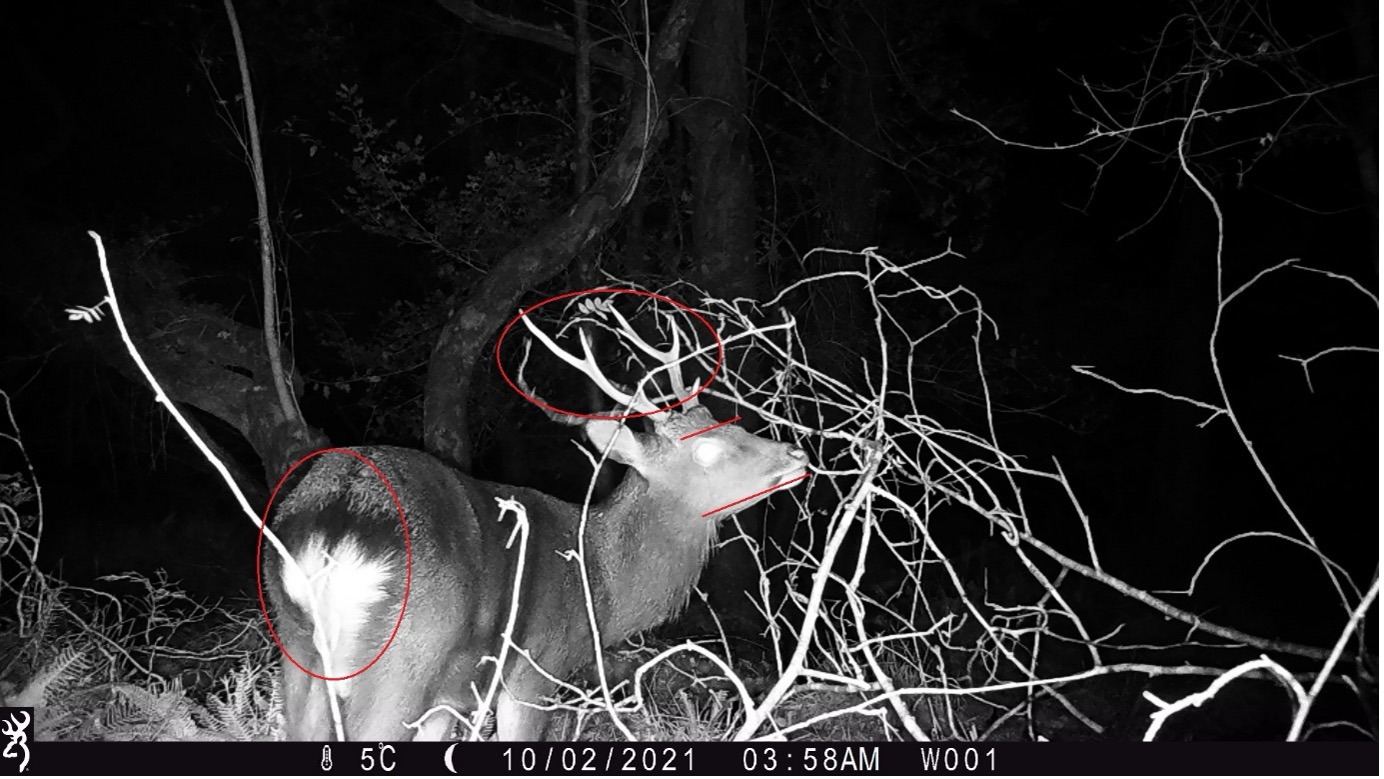
Another sika stag. Again, note the brow ridge, white rump patch surrounded by a black border and the tail without any markings, simply spiked antlers, and relatively short face. (Image: Simone Ciuti)
BrockWatch MammalWeb
Ever wondered who’s visiting your garden after dark? Join our brand new citizen science project, BrockWatch, and help us discover how badgers use our urban, suburban and rural spaces.
Spot a hog: garden survey
Spot a hog: garden survey is a pilot project to test the potential of monitoring hedgehogs in gardens using camera traps owned by the public.
Safeguarding Policy
MammalWeb Safeguarding Policy
|
POLICY INFORMATION |
|
|
Policy applies to: |
The policy applies to anyone working on behalf of MammalWeb including trustees, students and volunteers. The policy and procedures are mandatory for everyone involved with MammalWeb activities which engage with children and vulnerable and protected adults. |
|
Supporting documents |
This policy should be used in conjunction with other MammalWeb policies including our terms of use and privacy policy and project specific safeguarding policies (e.g., Connecting Schools to Nature). |
|
Adoption Date |
June 2024 |
|
Version number |
1 |
|
Review date |
June 2025 |
Purpose
At MammalWeb we embrace our duty of care to safeguard and promote the welfare of the children and adults at risk who we engage with, including our own trustees and volunteers. We are committed to ensuring our safeguarding practices reflect our statutory responsibilities, government guidance and the latest best practice. This policy also aims to ensure that everyone can have a positive, safe and enjoyable experience engaging with MammalWeb.
This policy applies to all individuals working on behalf of MammalWeb which includes trustees, students and volunteers. The ways in which MammalWeb may engage with children or vulnerable adults may include but are not limited to:
- Children and vulnerable adults registering and using the MammalWeb platform
- Research projects which involve engaging with children or vulnerable adults, including collecting data from these groups
- Public engagement events in different settings
- Being contracted by partner organisations to run training sessions or workshops with different community groups or in schools
We seek to safeguard children and vulnerable adults by:
- Valuing, listening to and respecting them
- Sharing information about safeguarding and good practice with those who engage with us, including our volunteers
- Sharing information about concerns with appropriate agencies who need to know, and involving carers, parents and children appropriately
- Responding swiftly and appropriately to all complaints and concerns about poor practice or suspected or actual abuse
- Keeping confidential, detailed, and accurate records of all safeguarding concerns in a professional and secure manner, in line with all relevant data protection legislation and best- practice guidance
- Ensuring any data we collect for research purposes is also in accordance with policies from the associated university, including having ethical approval where necessary
- Ensuring those who work directly with children or vulnerable adults hold a Disclosure and Barring Service check
- Having an appropriate and clear governance structure in place, which includes both a Designated Safeguarding Lead and Deputy
- Regularly reviewing and updating each of our policies and procedures to ensure ongoing compliance and best practice
Digital Engagement
MammalWeb recognises that with the majority of our engagement being online via our platform, there are specific risks that need to be considered and mitigated against. Therefore, we have included in this policy specific guidance to provide all who engage with MammalWeb virtually with the overarching principles of our approach to online safety.
In addition to the points stated above, we will seek to keep people online safe by:
- Regularly reviewing our online guidance and ensure the guidelines are followed by all those involved in the organisation
- Supporting and encouraging those who engage with MammalWeb to use the platform in a way that keeps them safe
- Reviewing our policies and procedures when new platform functionality is added. For example, our platform currently has no infrastructure for participants to communicate with each other. If this changes, we will ensure our policies and procedures are updated
- Ensuring that projects on MammalWeb specifically engaging with children or vulnerable adults have their own procedures and policies in place to safeguard individuals
- Following clear and robust guidelines to enable trustees and volunteers to respond appropriately to any incidents of inappropriate online behavior, whether by an adult or a child/young person.
- Reviewing and updating the security of our information systems regularly
- Ensuring that personal information about the children, young people and adults who we engage with is held securely and managed according to the UK GDPR Regulation
- Having clear procedures for dealing with inappropriate images which may be uploaded to the platform which includes having a ‘report’ button for participants to report inappropriate photos which will then be automatically removed from the system
- Ensuring that images and film of children, young people and adults are used only after a consent form has been obtained, and only for the purpose for which consent has been given.
How to Raise a Concern or Report an Incident
Whether engaging with MammalWeb physically (e.g., at a workshop or event) or digitally (via our platform), if you are worried about a child, young person or adult at risk, there are three different ways to raise your concerns and obtain advice and support:
- If you believe a child, young person or adult at risk is in immediate danger, or a crime is in progress, please call the police on 999 straight away. Alternatively;
- You can contact your Local Safeguarding Arrangement for Children or Adults, which will be made up of representatives from your local authority, health service and police force. Contact details can usually be found on your local authorities website.
- You can speak to the MammalWeb Designated Safeguarding Lead (or Deputy if unavailable). You can choose to make your report anonymously if you wish.
MammalWeb Designated Safeguarding Leads
The Designated Safeguarding Lead is a named person who is responsible for dealing with any concerns about the safeguarding.
Designated Safeguarding Lead and Lead Trustee for Safeguarding
Name: Steven Bradley
Phone: 07891752459
Email: This email address is being protected from spambots. You need JavaScript enabled to view it.
Deputy Safeguarding Lead
Name: Sammy Mason
Phone: 07807205651
Email: This email address is being protected from spambots. You need JavaScript enabled to view it.
Should these named people be unavailable, or if your concern relates to the designated safeguarding lead, then you should contact the relevant Local Safeguarding Arrangement for Children or Adults directly. If possible, check the area in which the at-risk person is from, to ensure the correct authority is contacted.
The roles and responsibilities of the Designated Safeguarding Leads:
- Ensure the MammalWeb Safeguarding Policy is followed and act as a source of advice on safeguarding matters.
- Ensure that everyone representing MammalWeb (including trustees, students and volunteers) are aware of what they should do and who they should go to if they have concerns that a child, young person or adult at risk may be experiencing, or has experienced abuse or neglect.
- Ensure that concerns are acted on, recorded in writing and referred to the appropriate body immediately.
- Follow up any safeguarding vulnerable people’s referrals and ensure the issues have been addressed.
- Reinforce the utmost need for confidentiality and to ensure that staff and volunteers are adhering to good practice with regard to confidentiality and security.
- Follow up any referrals or allegations, ensure verbal and telephone referrals are made in writing, and ensure the issues have been addressed.
- Ensure that any records are kept safely, securely and in line with data protection requirements
- Take part in any safeguarding training agreed by the board to be necessary for fulfilling the roles of Designated Safeguarding Leads.
What happens if a safeguarding concern is raised?
Where necessary, we will make a referral to a Local Authority Designated Officer (LADO) within one working day of the date of the disclosure and we will conclude any urgent internal reviews within three working days. Any information we receive will be treated with the strictest confidence and only shared as and when absolutely necessary. Your report will be securely filed in strict accordance with our Data Protection and Privacy Policies to assist any subsequent investigations by the police or social care services, and to enable us to monitor and evaluate our performance, establish any patterns or long-term issues, and identify any training or development needs.
NHMP - Cardiff
The National Hedgehog Monitoring Project aims to produce robust national population estimates for the much-loved hedgehog. This subproject collects images from sites in Cardiff contributing to the project.
North East Pilot Study: BTO Garden BirdWatch
The North East pilot study aims to determine the best camera trap placements in gardens for monitoring wildlife.
NHMP - Buckinghamshire
The National Hedgehog Monitoring Project aims to produce robust national population estimates for the much-loved hedgehog. This subproject collects images from sites in Buckinghamshire contributing to the project.

 English (United Kingdom)
English (United Kingdom)  Czech (Čeština)
Czech (Čeština)  Nederlands (nl-NL)
Nederlands (nl-NL)  Magyar
Magyar  Deutsch (Deutschland)
Deutsch (Deutschland)  Croatian (Hrvatski)
Croatian (Hrvatski)  Polski (PL)
Polski (PL)  Español (España)
Español (España)